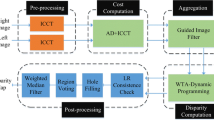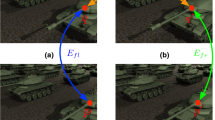Abstract
This paper presents a new intensity-based stereo algorithm using cooperative bidirectional matching with a hierarchical multilevel structure. Based on a new model of piecewise smooth depth fields and the consistency constraint, the algorithm is able to estimate the 3-D structure and detect its discontinuities and the occlusion reliably with low computational costs. In order to find the global optimal estimates, we utilize a multiresolution two-stage algorithm minimizing nonconvex cost functions, which is equivalent to the MAP estimation. This basic framework computing the 3-D structure from binocular stereo images has been extended to the trinocular stereo vision for a further improvement of the performance. A few examples for the binocular and trinocular stereo problems are given to illustrate the performance of the new algorithms.
Similar content being viewed by others
Explore related subjects
Discover the latest articles, news and stories from top researchers in related subjects.References
Barnard, S.T. 1989. Stochastic stereo matching over scale.Int. Journal of Computer Vision, 2:17–32.
Blake, A. and Zisserman, A. 1987. Visual Reconstruction. MIT Press, Cambridge, MA.
Burt, P.J. 1984. The pyramid as a structure for efficient computation, in the book (Rosenfeld 1984), pp. 6–35.
Chang, C. and Chatterjee, S. 1990. Multiresolution stereo—a Bayesian approach.Proc. of 10th Int. Conf. on Pattern Recognition, Atlantic City, NJ, pp. 908–912.
Chang, C., Chatterjee, S., and Kube, P.R. 1991. On an analysis of static occlusion in stereo vision.Proc. of IEEE Conf. on Computer Vision and Pattern Recognition, Hawaii, pp. 722–723.
Chung, R. and Nevatia, R. 1991. Use of monocular groupings and occlusion analysis in a hierarchical stereo system.Proc. of IEEE Conf. on Computer Vision and Pattern Recognition, Hawaii, pp. 50–56.
Enkelmann, W. 1988. Investigations of multigrid algorithms for the estimation of optical flow fields in image sequences.Computer vision, graphics and image processing, 43:150–177.
Geman, S. and Geman, D. 1984. Stochastic relaxation, Gibbs distribution, and the Bayesian restoration of images. IEEE Trans. Pattern Anal. Mach. Intelligence, 6:721–741.
Geiger, D., Ladendorf, B., and Yuille, A. 1992. Occlusions and binocular stereo.Proc. of 2nd Europe Conf. on Computer Vision, Italy, pp. 425–433.
Gennert, M.A. 1988. Brightness-based stereo matching.Proc. of 2nd Int. Conf. on Computer Vision, Tampa, FL, pp. 139–143.
Glazer, F. 1984. Multilevel relaxation in low-level computer vision, in the book (Rosenfeld 1984), pp. 312–330.
Grimson, W.E.L. 1985. Computational experiments with a feature based stereo algorithm.IEEE Trans. Pattern Anal. Mach. Intelligence, 7:17–34.
Hansen, C, Ayache, N., and Lustman, F. 1988. Toward real-time trinocular stereo.Proc. of 2nd Int. Conf. on Computer Vision, Tampa, FL, pp. 129–133.
Hoff, W. and Ahuja, N. 1989. Surface from stereo: Integrating feature matching, disparity estimation and contour detection.IEEE Trans. Pattern Anal. Machine Intell., 11:121–136.
Horn, B.K.P. 1986. Robot Vision, MIT Press, Cambridge, MA.
Luo, A. and Burkhardt, H. 1993a. Bestimmung des optischen Flusses aus Bildfolgen unter Berücksichtigung von Diskontinuität und Okklusion. In S.J. Pöppl und H. Handels (eds.),15. DAGM—Symposium “Mustererkennung”, Lübeck. Reihe Informatik aktuell, Springer, pp. 59–66.
Luo, A. and Burkhardt, H. 1993b. Shape from Shading (SFS) und Integration von SFS und Stereo unter perspektivischer Projektion. In S.J. Pöppl and H. Handels (eds.),15. DAGM—Symposium “Mustererkennung”, Lübeck. Reihe Informatik aktuell, Springer, pp. 584–591.
Luo, A. 1993. Helligkeitsbasiertes Rechnersehen zur direkten Ermittlung räumlicher Eigenschaften. Ph.D. Dissertation, Technische Universität Hamburg-Harburg.
Jones, D.G. and Malik, J. 1992. A computational framework for determining stereo correspondence from a set of linear spatial filters.Proc. of 2nd Europe Conf. on Computer Vision, Italy, pp. 395–410.
Marr, D. and Poggio, T. 1979. A computational theory of human stereo vision.Proc. Royal Soc. London B., 204:301–328.
Moravec, H.P. 1981. Robot Rover visual navigation. UMI Research Press, Ann Arbor, MI.
Rosenfeld, A. (eds.), 1984. Multiresolution Image Processing and Analysis, Springer-Verlag.
Stewart, C.V. and Dyer, C.R. 1988. The trinocular general support algorithm: a three-camera stereo algorithm for overcoming binocular matching errors.Proc. of 2nd Int. Conf. on Computer Vision, Tampa, FL, pp. 134–138.
Szeliski, R. 1990. Bayesian modeling of uncertainty in low-level vision.Int. Journal of Computer Vision, 5:271–301.
Terzopoulos, D. 1984. Multilevel reconstruction of visual surface: variational principles and finite-element representation in the book (Rosenfeld 1984), pp. 237–310.
Terzopoulos, D. 1986. Regularization of inverse visual problems involving discontinuities.IEEE Trans. Pattern Anal. Mach. Intelligence, 8:413–424.
Weng, J., Ahuja, N., and Huang, T.S. 1988. Two-view matching.Proc. of 2nd Int. Conf. on Computer Vision, Tampa, FL, pp. 64–73.
Author information
Authors and Affiliations
Rights and permissions
About this article
Cite this article
Luo, A., Burkhardt, H. An intensity-based cooperative bidirectional stereo matching with simultaneous detection of discontinuities and occlusions. Int J Comput Vision 15, 171–188 (1995). https://doi.org/10.1007/BF01451740
Received:
Revised:
Accepted:
Issue Date:
DOI: https://doi.org/10.1007/BF01451740




